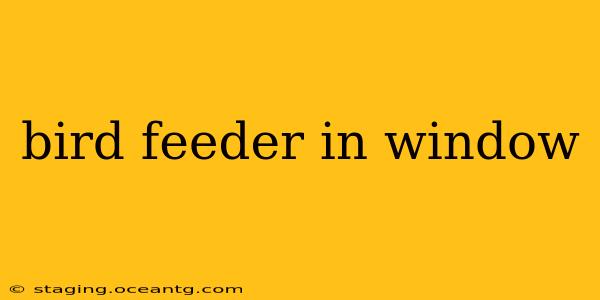Window bird feeders offer a unique and captivating way to enjoy the beauty of birds up close. Watching these delightful creatures flit and feed right outside your window brings nature's wonders directly into your home. But choosing and installing the right feeder requires some thought. This comprehensive guide will explore everything you need to know about selecting, installing, and maintaining a window bird feeder, ensuring a safe and enjoyable experience for both you and your feathered friends.
What are the benefits of a window bird feeder?
Window bird feeders provide unparalleled viewing opportunities. You can observe birds' behaviors, plumage details, and interactions from the comfort of your home, creating a fascinating and educational experience. This close proximity allows for incredible birdwatching without disturbing their natural routines. Furthermore, it's a great way to connect with nature and appreciate the biodiversity in your area.
What types of window bird feeders are available?
Several types of window bird feeders cater to different preferences and bird species. These include:
-
Suction cup feeders: These are easy to install and remove, ideal for renters or those who want flexibility. However, they may not be suitable for larger, heavier feeders or in areas with extreme weather conditions.
-
Mounted feeders: These feeders attach directly to the window frame using screws or brackets, offering greater stability and capacity. They are a good option for heavier feeders and locations exposed to strong winds.
-
Built-in feeders: Some window designs incorporate built-in feeders, offering a seamless and aesthetically pleasing integration. This is a more permanent solution, ideal for new constructions or renovations.
How do I choose the right bird feeder for my window?
Choosing the right feeder depends on several factors:
-
Window type: Consider the type of window (single or double pane, frame material) and the strength of the mounting system required.
-
Bird species: Different birds prefer different types of food and feeders. Research the local bird species to determine their preferences and select a feeder accordingly.
-
Feeder capacity: Choose a feeder with enough capacity to meet the needs of your local bird population. Larger feeders will require less frequent refilling.
-
Cleaning and maintenance: Select a feeder that is easy to clean and maintain to ensure hygiene and prevent the spread of disease.
What kind of birdseed should I use in my window bird feeder?
Different bird species have different dietary preferences. A good mix often includes:
-
Sunflower seeds: A favorite among many species, providing high energy and essential nutrients.
-
Nyjer (thistle) seeds: Popular with finches and siskins.
-
Milo: A grain preferred by doves and some sparrows.
-
White-striped sunflower seeds: These are larger than black oil sunflowers and are enjoyed by larger birds.
Avoid using bread, as it lacks nutritional value and can be harmful to birds.
How do I clean my window bird feeder?
Regular cleaning is crucial to prevent the spread of disease among birds. Empty and clean the feeder at least once a month, or more frequently during wet weather. Wash with warm soapy water and rinse thoroughly before refilling.
What are some safety considerations for window bird feeders?
-
Cat safety: Ensure cats cannot access the birds. Consider placing the feeder out of reach of cats or using deterrents.
-
Bird safety: Avoid placing the feeder too close to obstacles that could cause collisions.
-
Window placement: Don't place feeders near windows that receive direct sunlight, as it can overheat the feeder.
Are there any legal restrictions on window bird feeders?
Generally, there are no specific legal restrictions on window bird feeders, but it's always a good idea to check local regulations regarding bird feeding. Some areas may have restrictions related to specific bird species or disease prevention.
By following these guidelines, you can enjoy the wonder of watching birds up close and personal while ensuring their safety and well-being. Remember, responsible bird feeding contributes to a healthy ecosystem and provides endless hours of enjoyment.
